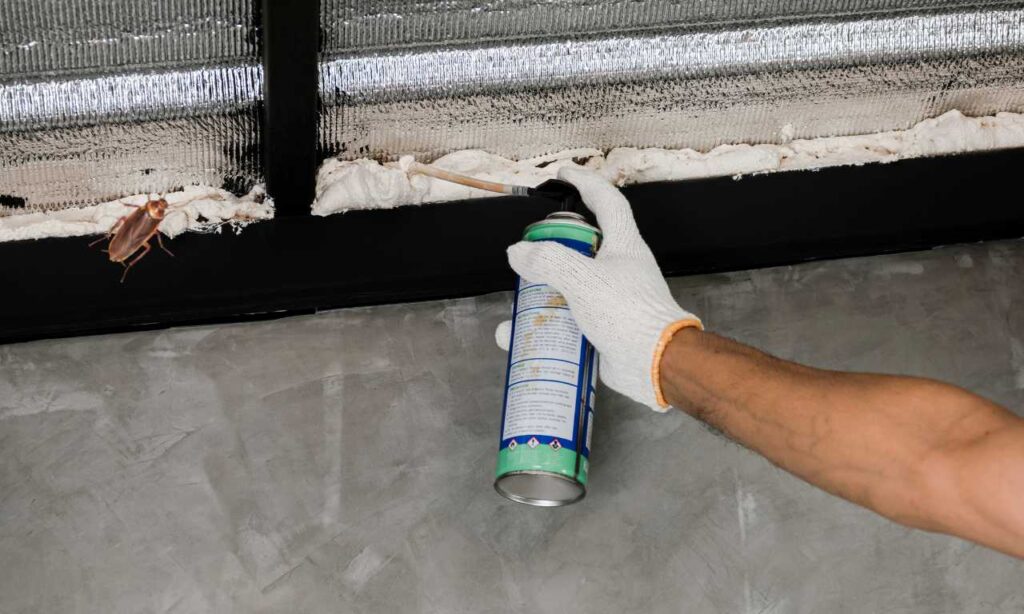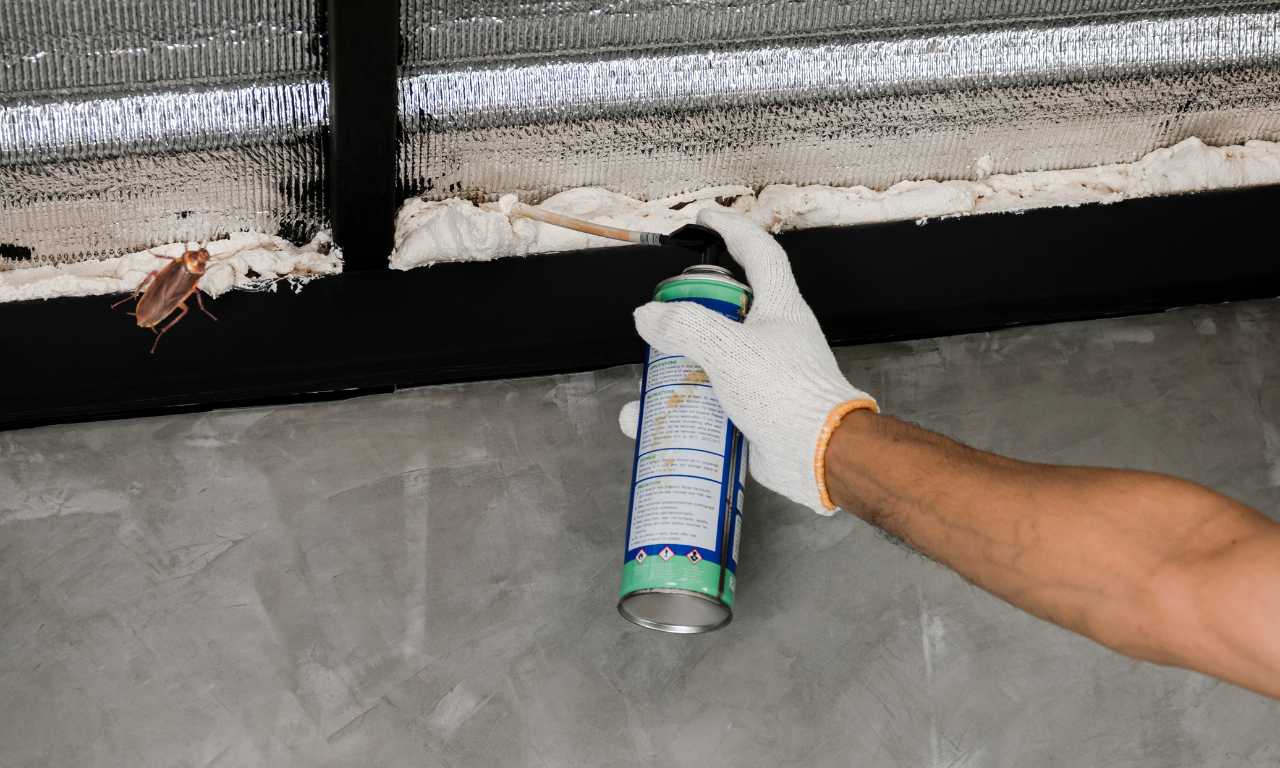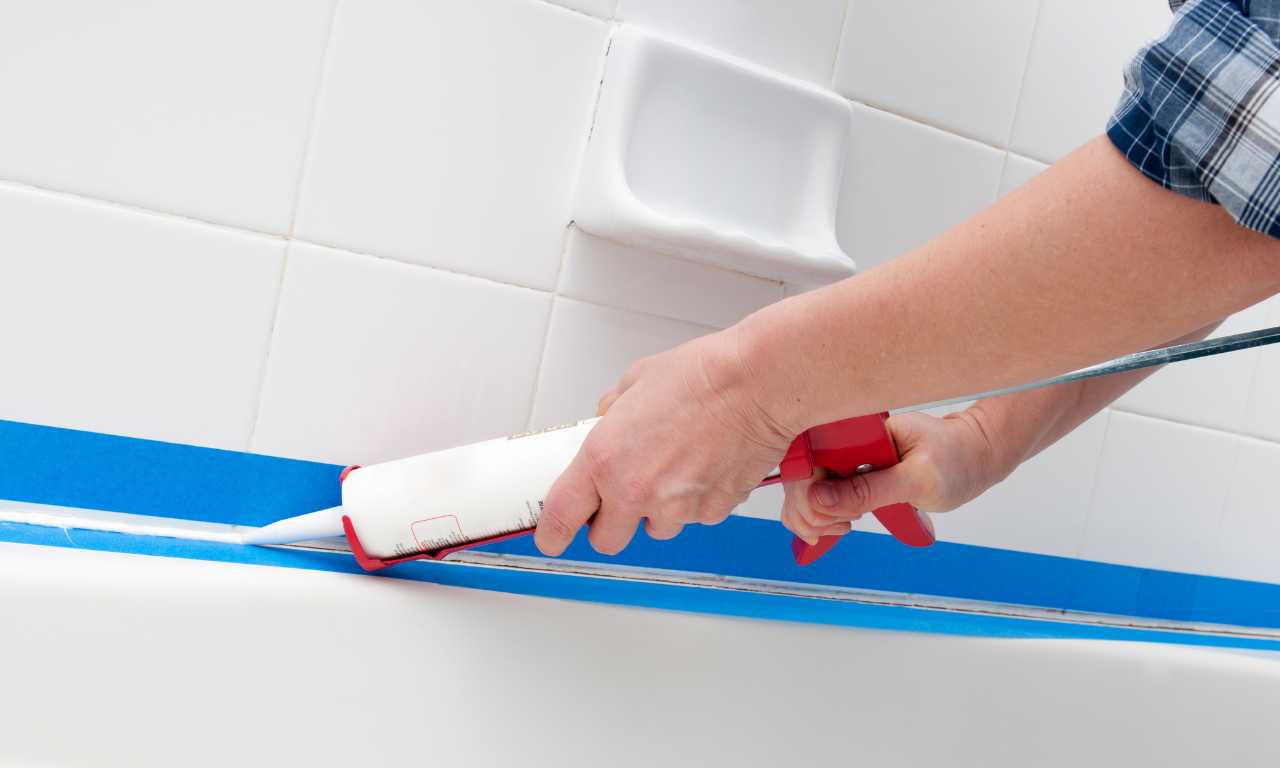
 Cockroaches can eat a variety of things including wood, paper, and glue, which is sometimes used as a component of caulk
Cockroaches can eat a variety of things including wood, paper, and glue, which is sometimes used as a component of caulk
However, the ability of roaches to eat through caulk is unlikely, as caulk is typically used for filling gaps and cracks in structures to prevent air, water, and insects from passing through. Roaches might be able to damage caulk if the material is old, damaged, or improperly applied.
It’s more likely that roaches will find their way into a building through other means, such as gaps around doors, windows, pipes, and electrical conduits, or by hitchhiking in boxes, bags, or other items brought inside.
Therefore, to prevent roaches from entering a building, it’s important to seal all potential entry points, including cracks, gaps, and holes, with a durable and properly applied caulk or other appropriate material.
Additionally, keeping a clean and well-organized environment, removing food and water sources, and using baits, traps, or insecticides as needed can help to reduce roach populations and keep them from becoming established in a building.
What Makes Caulk Difficult To Penetrate?
Caulk is typically made from a combination of polymers, fillers, pigments, and solvents that form a flexible, water-resistant sealant when applied. The specific composition of caulk can vary depending on the intended use, but it is generally formulated to adhere to a variety of surfaces, fill gaps and cracks, and prevent air, water, and insects from passing through.
One of the factors that makes caulk difficult to penetrate is its adhesive properties. Caulk is designed to stick to surfaces and form a tight bond, which helps to prevent it from cracking, shrinking, or becoming dislodged over time. This strong bond also makes it difficult for insects, including roaches, to burrow through it or remove it from the surface.
Another factor that contributes to the difficulty of penetrating caulk is its elasticity. Caulk is typically formulated to be flexible and to expand and contract with changes in temperature and humidity, which helps to prevent it from cracking or breaking. This elasticity can make it difficult for insects to create an opening in the caulk, as the material will simply stretch and return to its original position.
In addition to its adhesive and elastic properties, caulk is also formulated to be water-resistant. This helps to prevent water from penetrating the seal and causing damage to the underlying surface or structure. The water-resistant nature of caulk can also make it difficult for insects, including roaches, to consume it, as they typically need a moist environment to survive.
Finally, the color and texture of caulk can also make it difficult for insects to penetrate. Caulk is often formulated to blend in with the surrounding surface, making it difficult for insects to identify and locate. Additionally, the smooth, uniform texture of caulk can make it difficult for insects to grip or cling to it, which can prevent them from burrowing through it.
Best Way To Caulk To Keep Roaches Away
 To keep roaches away, it is important to caulk all potential entry points in a building, including gaps around doors, windows, pipes, electrical conduits, and any other areas where roaches might be able to enter. Properly sealing these entry points can help to prevent roaches from getting inside and establishing a population in the building. Here are some best practices for caulking to keep roaches away:
To keep roaches away, it is important to caulk all potential entry points in a building, including gaps around doors, windows, pipes, electrical conduits, and any other areas where roaches might be able to enter. Properly sealing these entry points can help to prevent roaches from getting inside and establishing a population in the building. Here are some best practices for caulking to keep roaches away:
- Choose the right caulk: Look for a caulk that is labeled as roach-resistant or that is specifically formulated to prevent insect penetration. Some types of caulk contain insecticides or other active ingredients that can repel or kill roaches.
- Clean the surface: Before applying caulk, clean the surface and remove any dirt, dust, or debris that might interfere with the bond. A clean surface will help the caulk to adhere better and create a tighter seal.
- Apply the caulk: Use a caulk gun to apply a continuous bead of caulk along the gap or crack, making sure to fill the entire area. Apply enough caulk to create a slightly rounded bead that is slightly higher than the surface. Use a caulk smoothing tool or your finger to smooth the surface and remove any excess caulk.
- Allow the caulk to dry: Most types of caulk will take several hours to dry completely. Be sure to follow the manufacturer’s recommendations for drying time and avoid disturbing the caulk while it is drying.
- Inspect and maintain the caulk: Regularly inspect the caulk to ensure that it is still adhering properly and that there are no gaps or cracks. Re-caulk any areas that have become damaged or dislodged over time.
In addition to caulking, there are other steps that can be taken to keep roaches away, including:
- Keep a clean environment: Remove food and water sources, store food in sealed containers, and regularly clean up any spills or crumbs. Roaches are attracted to moisture and food, so keeping a clean environment can help to reduce their population.
- Use baits, traps, or insecticides: If roaches are already present in a building, baits, traps, or insecticides can be used to reduce their population. Be sure to follow the manufacturer’s instructions and safety precautions when using these products.
- Seal all potential entry points: In addition to caulking, make sure to seal all other potential entry points, such as gaps around doors and windows, electrical conduits, and pipes. Use weather stripping, door sweeps, or other appropriate materials to create a tight seal.
By following these best practices for caulking and taking other steps to keep roaches away, you can help to reduce the risk of a roach infestation and keep your building free from these pests.
Are Silicon Caulk Effective?
Silicone caulk is a type of sealant that is often used for a variety of applications, including sealing gaps and cracks in buildings, around windows, doors, and other structures. Silicone caulk is known for its durability, flexibility, and resistance to temperature extremes and moisture, making it an effective option for many sealing applications.
In terms of effectiveness in preventing roaches, silicone caulk can be an effective solution in certain circumstances. The durability and flexibility of silicone caulk can make it difficult for roaches to penetrate or burrow through, as the material will simply stretch and return to its original position. Additionally, silicone caulk is water-resistant, which can make it difficult for roaches to consume it and may also help to prevent moisture from penetrating the seal and attracting roaches.
However, it is important to note that silicone caulk is not typically formulated to contain insecticides or other active ingredients that can repel or kill roaches. While silicone caulk can be an effective barrier against roaches, it is not a substitute for other pest control measures, such as baits, traps, or insecticides.
In addition, it is important to properly apply silicone caulk to ensure its effectiveness. This includes cleaning the surface before applying the caulk, applying a continuous bead of caulk along the gap or crack, allowing the caulk to dry completely, and inspecting and maintaining the caulk over time.
Caulk That Contains Boric Acid
Boric acid is a naturally occurring compound that is often used as an active ingredient in various pest control products, including caulk. Caulk that contains boric acid is formulated to provide an added level of protection against roaches and other pests by killing or repelling insects that come into contact with the caulk.
The effectiveness of caulk that contains boric acid depends on several factors, including the concentration of boric acid in the caulk, the frequency of contact with the caulk, and the susceptibility of the specific species of roaches or other pests. Boric acid works by disrupting the digestive system and nervous system of insects that come into contact with it, causing them to dehydrate and die.
When using caulk that contains boric acid, it is important to follow the manufacturer’s instructions and safety precautions. Boric acid can be toxic to humans and pets if ingested, so it is important to keep the caulk out of reach of children and pets.
Additionally, it is important to properly apply the caulk, following the same best practices for caulking, including cleaning the surface before applying the caulk, applying a continuous bead of caulk along the gap or crack, allowing the caulk to dry completely, and inspecting and maintaining the caulk over time.
Name Of Caulks That Contains Boric Acid
There are several brands of caulk that contain boric acid as an active ingredient. These caulks are specifically formulated for use in pest control and are marketed as being effective against roaches and other pests. Some of the most well-known brands of caulk that contain boric acid include:
- DAP Borateem Caulk: This caulk is formulated with boric acid and is marketed as an effective solution for preventing roaches, ants, and other pests. It can be used for both indoor and outdoor applications and is easy to apply with a standard caulk gun.
- D-Fresh Boric Acid Caulk: This caulk is specifically designed to be used in kitchens, bathrooms, and other areas where roaches and other pests are commonly found. It contains boric acid as an active ingredient and is formulated to provide a long-lasting barrier against pests.
- Ortho Home Defense Max Caulk: This caulk is formulated with boric acid and is marketed as an effective solution for preventing roaches, ants, and other pests. It can be used for both indoor and outdoor applications and is designed to be easy to apply with a standard caulk gun.
- Termidor SC Caulk: This caulk is formulated with the active ingredient fipronil, which is a powerful insecticide that is known for its effectiveness against roaches and other pests. In addition to fipronil, this caulk also contains boric acid for added protection against pests.
It is important to note that while these caulks contain boric acid as an active ingredient, they may also contain other ingredients that are designed to enhance the effectiveness of the boric acid. Additionally, it is important to follow the manufacturer’s instructions and safety precautions when using these caulks, as boric acid can be toxic to humans and pets if ingested.
Welcome to my blog. I have been doing pest control for years since my house, garden and pets were always attacked by various kinds of pests and as a result I had to know proper pest control techniques that works. In this blog I share all the tips and tricks that I know and I hope you’ll find it helpful.
